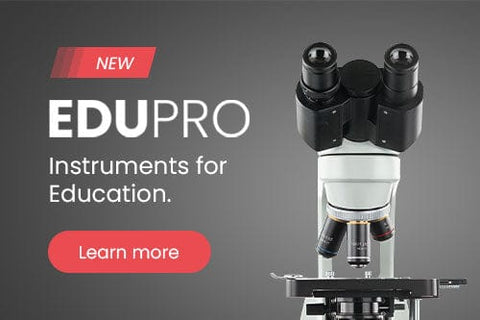- Microscopes
- Cameras
- Lab Supplies & Equipment
- Shop By Brand
- Lab Supplies by Category
- Analyzer Consumables
- Balances
- Bags
- Beakers
- Bench Scale Bases
- Bottles
- Bottletop Burettes
- Bottletop Dispensers
- Boxes
- Blank Microscope Slides & Cover Slips
- Blood Collection
- Caps
- Carboys
- Centrifuges
- Centrifuge Tubes
- Cold Storage
- Containers
- Cryogenic Vials
- Culture Tubes
- Cylinders
- Dispensers
- Digital Dry-Baths
- ESR Products
- False Bottom Tubes
- Flat Bottom
- Funnels
- Gel Documentation
- Glassware
- Glass Test Tubes
- Histology
- Homogenizers
- Hotplates-Stirrers
- Inoculation Loops and Spreaders
- Liquid Handling Products
- Manual-Electronic Pipettors-Pipettes
- Microscope Slides
- Overhead Stirrers
- Pipette Controller (Serological Filller)
- Pipette Tips
- Plastic Test Tubes
- PCR Tubes, Strips & Plates
- Racks
- Repeater Pipettor
- Rockers
- Rotary Evaporators
- Serological Pipettes
- Shakers
- Spectrophotometers
- Syringe Tips
- Sample Tubes
- School/Classroom Supplies
- Screwcap Test Tubes
- Self-Standing
- Test Tube Racks
- Test Tubes & Vials
- Transport & Storage Tubes
- Thermal Mixers
- Transfer Pipets
- Urinalysis
- Vacuum Pumps
- Weighing Dishes
- Lab Equipment
- Balances
- Bench Scale Bases
- Centrifuges
- Digital Dry-Baths
- Gel Documentation
- Homogenizers
- Hotplates-Stirrers
- Overhead Stirrers
- Pipettors
- Rockers
- Rotary Evaporators
- Shakers
- Serological Pipettes
- Spectrophotometers
- Thermal Mixers
- Vacuum Pumps
- Liquid Handling Products
- Manual-Electronic Pipettors-Pipettes
- Pipette Tips
- Racks
- Pipette Fillers-Controllers
- Repeater Pipettor
- Syringe Tips

Cost effective products and solutions designed to improve laboratory efficiency, safety and results.
SHOP BENCHMARK SCIENTIFIC >
- Slides & Accessories
- Slides
- Cameras
- Illuminators
- Adapters
- Eyepieces / Objectives
- Bulbs
- Magnifying Lamps
- Monitors and Tablets
- View All Categories
- Adapters
- DSLR Adapters
- USB Camera Adapters
- Ring Light Adapters
- Power Adapters
- Barlow Lens
- Books & Experiments Cards
- Bags & Cases
- Bags
- Cases
- Cameras
- Circuit Board Holders
- Cleaning Kits
- Condensers
- Darkfield
- Phase Contrast Kits
- Polarizing Kits
- Dust Covers
- Eye-Guards
- Eyepieces
- 20mm
- 23mm
- 30mm
- 30.5mm
- Filters
- Microscope Filters
- Illuminator Filters
- Fluorescence Kits
- Conversion Kits
- Filter Cubes
- Focusing Racks
- Fuses
- Illuminators
- Bulbs
- LED Illuminators
- Fiber Optic Illuminators
- Fluorescent Illuminators
- Ring Lights
- Stand Lights
- Goosenecks
- Gooseneck Attachments
- Immersion Oils
- Loupes
- Magnifying Lamps
- Clamp Lamps
- Desktop Lamps
- Rolling Stand Lamps
- Mechanical Stages
- Monitors and Tablets
- Calibration Slides & Stage Micrometers
- Stage Warmers
- Stain Kits
- Stands
- Articulating Arm Stands
- Boom Stands
- Table Stands
- Tweezers
- Other Accessories
- Shop By Industry
- Shop By Industry
- Botany
- Agronomy & Forestry
- Horticulture
- Phytopathology
- Chemistry
- Biochemistry
- Biotechnology
- Cannabis
- Pharmaceutics
- Consumables
- Beer & Wine
- Cosmetics
- Food & Beverage
- Electronics
- Circuit Boards & General Electronics
- Mobile Phone Repair
- Semiconductors & Wafers
- Environmental
- Asbestos
- Ecosystem Research
- Mud Logging
- Soil Treatment
- Water Treatment
- Forensics
- Ballistics
- Fingerprint Analysis
- Genetic Identification
- Hair & Fiber Analysis
- Handwriting Analysis
- Industrial
- Aerospace
- Automotive
- Dental Lab & Production
- Glass Industry
- Industrial Inspection
- Mechanical Parts
- Paper Industry
- Petrochemical
- Plastics
- Printing Industry
- Quality Assurance & Failure Analysis
- Textiles & Fibers
- Tool Making
- Wood Production
- Jewelry & Gemology
- Engraving
- Gemology
- Jewelry Repair
- Stone Setting
- Watch Repair
- Hobby
- Coins & Collecting
- Stamps
- Modeling & Assembly
- Sculpting
- Repair
- Telescopes
- Metallurgy
- Archaeology
- Geology
- Mining
- Petrology
- Medical & Microbiology
- Anatomopathology
- Bacteriology
- Biochemistry
- Cell Culture
- Cytology
- Dental Microbiology
- Dermatology
- Dissection
- Gout & Rheumatology
- Hair & Fiber Analysis
- Hair Transplant
- Fluorescence
- Hematology & Live Blood Analysis
- Histopathology
- Mycology
- Medical Devices
- Microsurgery
- Neuropathology
- Oncology
- Parasitology
- Pathology
- Semen Analysis
- Virology
- Veterinary & Zoology
- Breeding & Semen Analysis
- Entomology
- Fecal Smears & Floats
- Marine Biology
- Ornithology
- Veterinary Medicine
- Zoology
- Shop By Industry
- Students
- Telescopes
- Buy With Prime
- Sale
- Compound Microscopes
- Shop By Brand
- AmScope
- Euromex
- Omax
- Shop by Head Type
- Binocular
- Monocular
- Trinocular
- Multi-head & Training
- Shop By Specialty
- Brightfield
- Darkfield
- Phase Contrast
- Inverted
- EPIfluorescence
- Polarizing
- Digital Integrated
- Metallurgical
- Shop By Application
- Education
- Research
- Veterinary
- Compound With Digital Head
- Shop Best Sellers
- Shop All Compound
- Stereo Microscopes
- Shop By Brand
- AmScope
- Euromex
- Shop By Objective Type
- Fixed Power
- Zoom Power
- Single Lens
- Common Main Objective
- Shop By Stand Type
- Articulating Arms
- Boom Stands
- Gooseneck Stands
- Table Stands
- Other Stands
- Shop By Head Type
- Binocular
- Monocular
- Trinocular
- Simul-Focal
- Shop By Industry
- Video Inspection
- Industrial Inspection
- Microscope Heads
- Shop Stands
- Articulating Arm
- Boom Stands
- Table Stands
- Stereo With Digital Head
- Shop Best Sellers
- Shop All Stereo
- Specialized Microscopes
- Digital Microscopes
- Kids, Student Microscopes
| AmScope Blogs
The Basics of Microscope Magnification: Everything You Need to Know
In many disciplines, the microscope is a scientist’s best friend. It’s the trusty sidekick that provides insight, clarity and new perspectives as you dive into uncharted territory. We interact with microscopes so often that operating them can become sheer muscle memory, and we no longer think about why we use them as we do. In this article, we’ll take a step back to reacquaint ourselves with the basic tenets of microscope magnification.
What Is Magnification?

Simply put, magnification refers to how much an object is visually enlarged when observed under a microscope. It’s usually represented in terms of x–for instance, 2x, 10x and 20x mean that the observable object appears to be twice as big, 10 times as big or 20 times as big when viewed through the microscope eyepiece. Like all things, even your microscope’s magnification has limits. Analog microscopes that use light and mirrors to magnify objects usually max out at about 1,500x magnification. This is because light wavelengths cause the image to appear unclear at that magnitude of magnification. Electron microscopes, however, can produce images that exhibit impressive clarity all the way up to 200,000x magnification since electrons have much shorter wavelengths.
Measuring Magnification

Most compound light microscopes have two types of lenses–the ocular lens and the objective lens. The ocular lens is the lens on the eyepiece. The objective lens is the lens closest to the object or slide being observed. Most microscopes have a rotating disc with at least three objective lenses attached, so the observer can choose an appropriate magnification. In order to measure the total magnification, you must calculate the product of the ocular lens and the objective lens. To do this, record the magnification of the ocular lens in the eyepiece and record the magnification of the objective lens (these numbers are usually engraved on the sides of both types of lenses). Next, multiply the ocular lens magnification by the objective lens magnification. This will give you the total magnification. For instance, if you are using an ocular lens with 10x magnification and an objective lens with 50x magnification, your total magnification is 500x.
Adjusting Magnification
By switching up the configuration of your lenses, you can achieve a wide range of microscope magnification. A standard microscope eyepiece magnifies an object 10x. However, you can find eyepieces that magnify 15x, 20x and even 30x or higher. This presents a plethora of options in terms of combining the ocular and objective lenses to reach the perfect point of magnification. To adjust the magnification, simply switch out the ocular and/or the objective lenses until you find the ideal combination for viewing your sample or slide. Remember, the highest magnification is not always the best, as compound light microscopes can really only magnify up to a certain point before the images lose clarity and become unreliable.
Things to Keep in Mind

Knowing how to measure and adjust your microscope are the building blocks for microscopy skills. But what other factors can affect how you view your sample? For starters, make sure the stage is all the way down and locked into place. The stage is the flat surface on which you rest your slide or sample for viewing. If it isn’t in a fixed position, you may have a hard time bringing your image into focus. When using the coarse adjustment knob to move the lenses up and down, or further away and closer to your objective, make sure you do not bring the lenses close enough to touch the slide. This could result in something as simple as bumping the slide and having to refocus, or as impactful as actually crushing your sample. As with any laboratory equipment, proceed carefully and with caution to prevent any unnecessary lab mishaps.
Compound light microscopes are relatively easy-to-use machines, as long as you take care of them properly and understand the basics of magnification. Through the wide variety of ocular and objective lens combinations, you can visualize whole worlds in a slide, and maybe even make some surprising discoveries. Understanding the basics of microscope magnification can enable you to use this common piece of lab equipment to your best advantage.
Free Shipping on orders $149+
Same day shipping for orders within the contiguous U.S.
Easy Returns
Hassle-free 30-day return policy. 100% satisfaction guarantee.
Quality Products
5-year warranty on AmScope microscopes.
Got a question?
Speak to our team of experts and find the products you need.
















